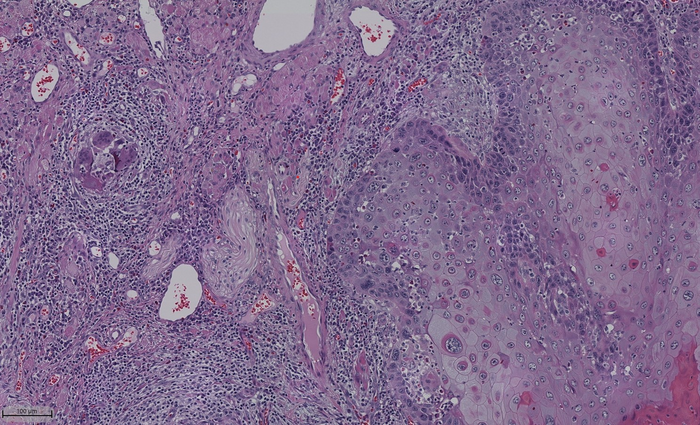Researchers at the University of Michigan Rogel Cancer Center and the School of Dentistry identified a new metric to articulate the relationship between nerve density and oral cancer. The study, published in Clinical Cancer Research, a journal of the American Association for Cancer Research, investigated normalized nerve density to translate previous mechanistic studies into a context that could be used in the clinic.
"We are recognizing more and more that there's a very dynamic interaction between nerves and cancer cells in the tumor microenvironment," said Nisha D'Silva, B.D.S., M.S.D, Ph.D., Donald Kerr Endowed Collegiate Professor of Oral Pathology and senior author.

The team created a standardized metric for nerve density to clarify the variation in the distribution of nerves in the oral cavity, called normalized nerve density, and showed its importance in tumor progression. Image Credit: Cindy Perez-Pacheco
The team looked at how the density of nerves within a tumor tied with the tumor's growth. The oral cavity has several regions, each with different functions. The way each area receives nerves is distinct; the nerves on the inside of the cheek have a different role and are fewer than nerves on the tongue. Given these variations, looking at the nerve density of the tumor without considering the normal innervation of the different areas in the oral cavity and each individual's variation to assess whether a tumor is aggressive leaves an inaccurate picture.
To account for this, the team created a standardized metric for nerve density to clarify the variation in the distribution of nerves in the oral cavity, called normalized nerve density and showed its importance in tumor progression. Most of the work was done with human tissue, and the team then validated the findings using a mouse model.
They used adjacent tissue to compare and determine a "normalized" density for different regions in the oral cavity. "We showed that tumors with high normalized nerve density seem to be associated with poor survival for patients with tongue cancer, which is the most common type of oral cancer," D'Silva explained. "We also found that patients with high normalized nerve density and a smaller distance between the nerve and the tumor have poorer outcomes."
Additionally, the team explored the use of artificial intelligence to measure normalized nerve density, which could facilitate the use of this metric in clinical practice.
A challenge with treating oral cavity cancer is their tendency to recur. "The question becomes, how can you look for factors that could contribute to progression? How can you use nerve features to figure out which cancers will behave more aggressively?" D'Silva explained.
She says if researchers can figure out which cancers will behave more aggressively from the outset, then they could treat the tumors more aggressively from the beginning. Normalized nerve density provides researchers with another data point to determine the best course of treatment.
Source:
Journal reference:
- Perez-Pacheco, Ligia B. Schmitd, Allison Furgal, Emily L. Bellile, Min Liu, Aya Fattah, Laura Gonzalez-Maldonado, Shelby P. Unsworth, Sunny Y. Wong, Laura S. Rozek, Arvind Rao, Gregory T. Wolf, Jeremy M.G. Taylor, Keith Casper, Michelle Mierzwa, Nisha J. D'Silva; Increased Nerve Density Adversely Affects Outcome in Oral Cancer. Clin Cancer Res 2023; https://doi.org/10.1158/1078-0432.CCR-22-3496, https://aacrjournals.org/clincancerres/article-abstract/doi/10.1158/1078-0432.CCR-22-3496/725163/Increased-Nerve-Density-Adversely-Affects-Outcome?redirectedFrom=fulltext